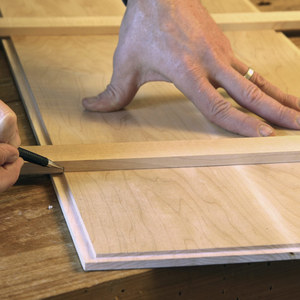Interlocking Chinese Joinery
In this video, Andrew Hunter demonstrates some other amazing interlocking joineryFor centuries, Chinese cabinetmakers have been constructing beautiful and well-engineered pieces. Andrew Hunter studied the secrets behind ancient Chinese joinery, and was inspired to share them with you in this video. He shows four joints that do not use glue, allowing the pieces to be both strong and reversible.
More on FineWoodworking.com:
- This how-to by Andrew is a step-by-step guide on creating a 3-way miter; a joint that has been used since the Ming dynasty, and is known for its strength and seamlessness.
- In this article, Andrew shows you how to make strong, yet slender, frame-and-panels using dovetailed battens.
- Andrew gives directions here on how he uses both shouldered and unshouldered sliding dovetails to secure tabletops to their bases.

Get the Plan
Andrew's Country Pine Hutch plan is one of our best selling.






















Comments
Wow, those joints are both intriguing and intimidating! Great video that took time to explain things!
Wonder how much time is invested in creating one of those 3-way corner joints?
Are there any primary differences between Chinese and Japanese joinery or are they basically the same? Does one culture pre-date the other?
Were the joints completely made with hand tools or was there a balance with power tools? Would traditional Chinese joinery employ power tools?
He said that he used both power and hand tools.
I'm pretty sure he said he used a power router.
I immediately ordered both books. Can't wait to make these joints and then incorporate them into my work. That's going to be awesome. That's why I love this site so much. And the Magazine. Years and Years of knowledgeable information. It's a Beautiful thing.
Wonderful insight into not only the how but the why of traditional techniques. Clearly when you see a 900 year old piece of furniture held together without glue or nails the techniques deserves closer inspections. Its amazing how much they understood about their materials.
My initial thought was that I would never spend so much time on the three-way joints, but by the end of the video I really wanted to try the sliding dovetail battens for a frame and panel. A gem of time-tested construction.
Very clean joinery and worth a try just for the mental exercise. Why doesn't that wide panel swell and shrink and push the frame apart?
Chrismitchell - what books did you order?
Will FW show us a segment of this craftsman actually making a joint(s)?
Love the statement, ''Once you get past the layout (perfectly)...it's just wood working''. That statement comes from understanding, confidence and expierence. I've restored (repaired) many of these joints on rosewood display cases.
Regarding the frame and panel piece. Just a few comments in regards to function and design. #1, I might have mitred the edges of the end frames (1/2" deep lap) with a mitre at the end so no end grain showed. I would have stoppped the tennons for the same reason. #2 I would have used a paralle dovetail slides to allow for expansion and contraction of the panel. But all in all a beautiful piece of woodworking.
All of the videos I've seen here of Andrew Hunter's woodworking have been excellent. More, please.
Beautiful ancient ingenuity. FW, thank you so much for sharing this with us. At 18:55 Andrew puts an intriguing idea in my mind...how about scientifically compression testing a panel on its diagonal compared with a conventional panel of similar species? i would love to see those numbers. How much force can this brilliantly engineered structure withstand? I think this would prove productive in inspiring woodworkers to employ this time-consuming joinery technique in their furniture constructions.
That's very interesting, but PLEASE, DO NOT SHOOT AND EDIT interlaced video. It's year 2017, FFS.
Stunning.
Great insight to the concept of the interlocking joinery. Ben Strano does a good job of letting the guest explain his work, rather than trying to show how much Strano knows about the subject matter. I appreciated the display of the different joints and their applications. It is amazing how much work Andrew Hunter can produce with just that small cache of hand tools!
Andrew is obviously passionate about the craft. Thanks for the insight and thorough explanation.
Log in or create an account to post a comment.
Sign up Log in